
by Taylor Vandiver | Feb 25, 2014
So you have alkaline soil… What next?
Throughout the Panhandle, a common problem that often arises is finding a way to raise soil pH. This is due to the fact that we often encounter sandy, acid soils in this region. An often overlooked issue is explaining the process of gardening in a soil that tends to be more alkaline in nature.
Soil pH is measured using a scale from 0 to 14. On this scale, a value of 7 is neutral, pH values less than 7 are acidic, and pH values greater than 7 are alkaline. Soil pH directly affects the growth and quality of many landscape plants. Extreme pH levels can prevent certain nutrients from being available to plants. Therefore, a high pH may make it difficult to grow certain plants.
Often alkaline soils occur in the home landscape as a result of calcium carbonate-rich building materials (i.e., concrete, stucco, etc.) that may have been left in the soil following construction. Soils that contain limestone, marl or seashells are also usually alkaline in nature. There are a few measures that can be taken in order to combat high pH. Incorporating soil amendments containing organic material is the most common method implemented to reverse alkalinity. Peat or sphagnum peat moss is generally acidic and will lower pH better than other organic materials. Adding elemental sulfur is another common practice. A soil test will need to be performed often in order to add the correct amount of sulfur to reach an optimal pH level.
Lowering the pH of strongly alkaline soils is much more difficult than raising it. Unfortunately, there is no way to permanently lower the pH of soils severely impacted by alkaline construction materials. In these circumstances, it may be best to select plants that are tolerant of high pH conditions to avoid chronic plant nutrition problems.
Some plants that will tolerate alkaline soils:
-
Shrubs
- Glossy Abelia (Abelia Xgrandiflora)
- Sweet Shrub (Calycanthus floridus)
- Flowering Quince (Chaenomeles speciosa)
- Burford Holly (Ilex cornuta ‘Burfordii’)
- Indian Hawthorne (Rhaphiolepis indica)
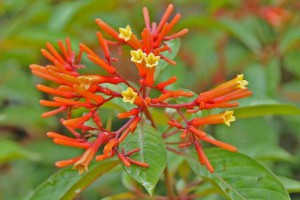
Firebush is wonderful butterfly attractant. Photo courtesy of UF/IFAS.
-
Perennials
- Larkspur (Delphinium carolinianum)
- Pinks (Dianthus spp.)
- Firebush (Hamelia patens)
- Plumbago (Plumbago ariculata)
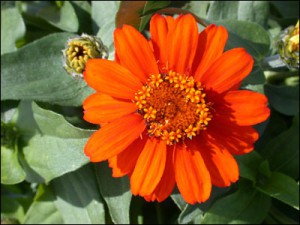
Zinnias come in a variety of colors, shapes and sizes. Photo courtesy of UF/IFAS.
-
Annuals
- California Poppy (Eschscholzia californica)
- Zinnias (Zinnia spp.)
- Cosmos (Cosmos bipinnatus)
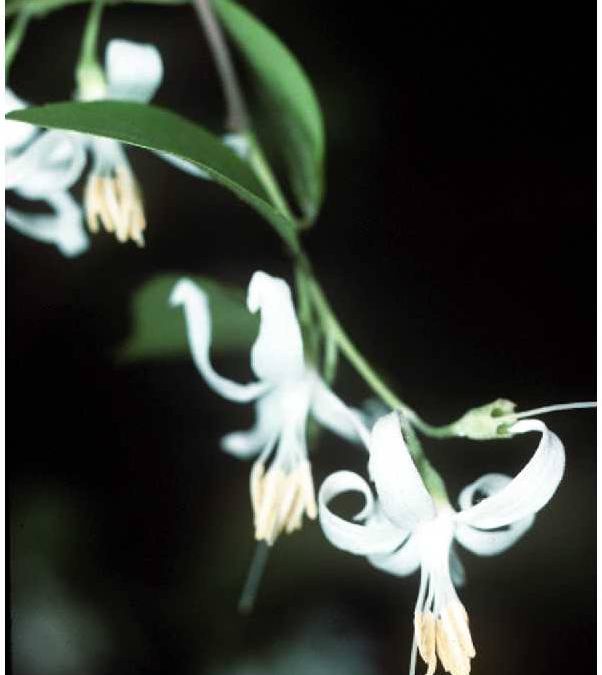
by Alex Bolques | Feb 4, 2014
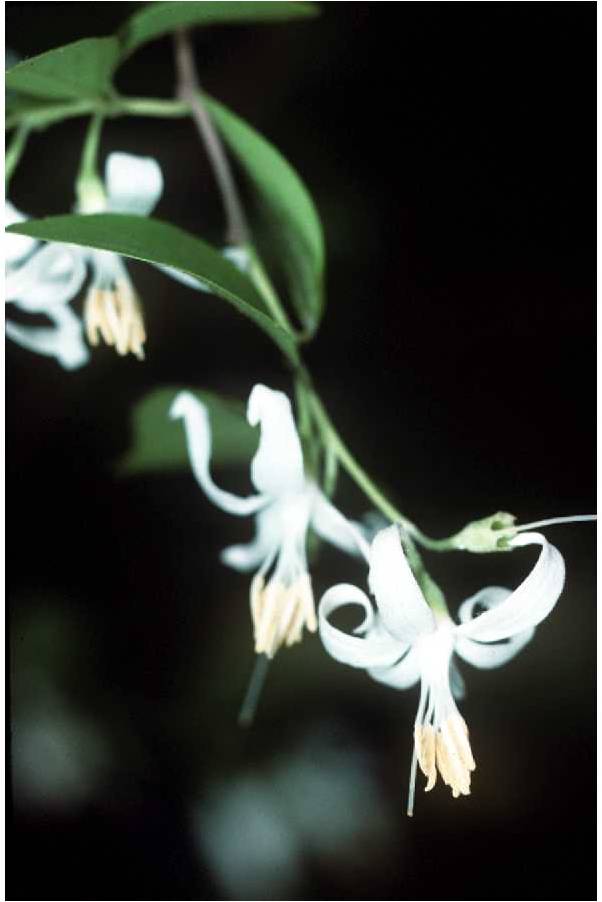
Robert H. Mohlenbrock @ USDA-NRCS PLANTS Database / USDA SCS. 1991. Southern wetland flora: Field office guide to plant species. South National Technical Center, Fort Worth.
Found throughout the North Florida Panhandle, the American snowbell, Styrax americanus, is a native small flowering tree. In his book, The Trees of Florida, Gil Nelson describes the blossoms as charming with “the thin, reflexed (flower) petals curve back over the flower base, leaving an attractive mass of yellowish stamens protruding from the star-shaped corolla”. It has dark green deciduous foliage, with the tree reaching up to 16 feet in height. The attractive blooms appear April – July.
Considered as an understory tree, American snowbell grows best in wet partially shaded areas and is somewhat tolerant of full sun. It prefers wet places such as swamps, wet woods, edges of cypress ponds and moist to wet, cool, acid sandy to sandy loam soils. Wet areas of the home landscape where water puddles occur provide adequate growing conditions for the American snowbell.
Wildlife benefits include nectar for bees and butterflies and edible fruit for birds. To try American snowbell in the landscape, check with local native plant nursery or search online. Note: other Styrax species can be found online that are non-native.
Other source: The Native Plant Database
by Taylor Vandiver | Nov 11, 2013
As I made a visit back to my hometown in North Alabama I was reminded of the subtle changes from fall into winter, which are not always apparent to me living in Tallahassee: the vibrant palette of leaves as they make their permanent descent until spring, the litter of spent cotton along each highway and county road and the annual pecan harvest that has been a tradition in my family for as long as I can remember.
Due to the variations in climate and topography from upper Alabama to the panhandle of Florida, our seasons can differ greatly. However, I know of one entity that remains a constant and that is the availability of pecans. Pecan trees (Carya illinoinensis) are a common sight throughout the South. They can be spotted as far west as Texas and as far north as Illinois. The pecan tree is native to the Mississippi floodplain, which has deep, fertile, well-drained soils. Before the arrival of Europeans, Native Americans used pecans as a primary food source for thousands of years.
What’s more, pecans have major economic value. The annual value of pecans in the United States is estimated at 200 to 500 million dollars. Florida produces from five to ten million pounds of pecans annually. The majority of that pecan production acreage (6,500 acres) can be found in North Florida. While the nut is the main attractant of the tree, there’s not much that warms the heart more than seeing pecan pie at the dessert table on Thanksgiving.
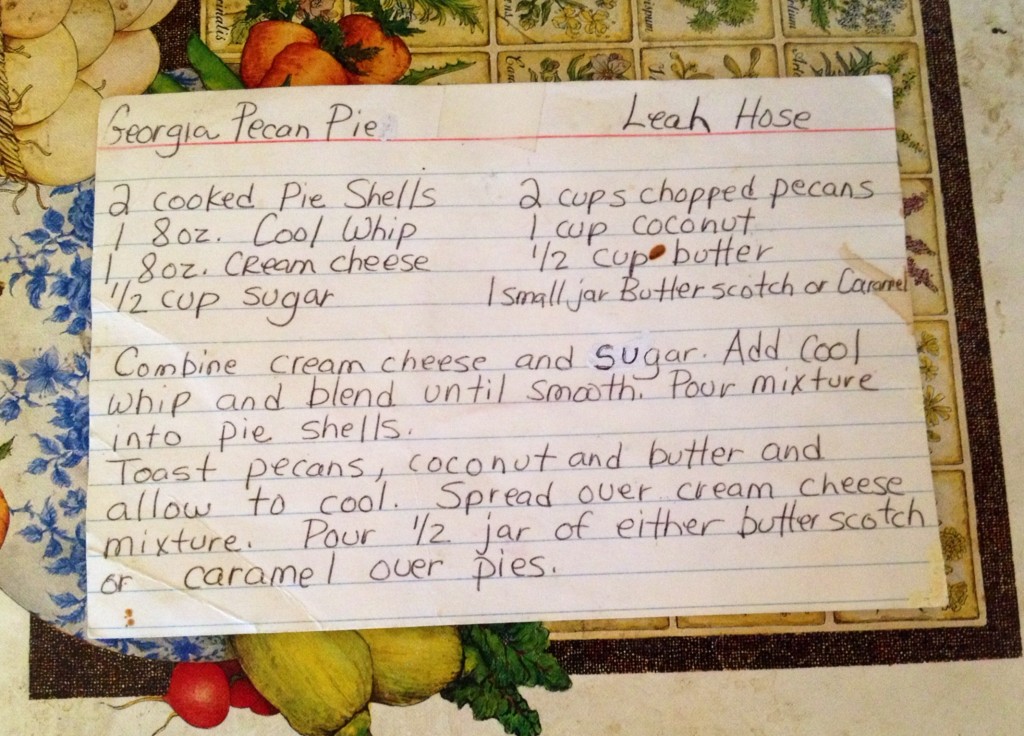
A well worn recipe for southern pecan pie that has been passed down through my family.
Pecan trees are deciduous, which means that they drop their leaves in the winter. An additional consideration for those planning to install pecan trees is to be aware that they are wind-pollinated and that their male and female flowers often do not mature at the same time. Therefore, in order to ensure the possibility of high yields, two or more cultivars should be planted together for cross-pollination.
Be sure to choose a variety like ‘Elliot’ or ‘Curtis’ that has good disease resistance, is suited for North Florida and will cross-pollinate well. Plant pecans during the colder months to allow for root growth before spring. The optimum soil pH for pecans is 5.5 to 6.5. At the lower end of this range, micronutrient deficiency symptoms should be less common. Pecan trees should start producing decent crops in six to twelve years. A tree at maturity can reach up to seventy feet tall so plan spacing and placement accordingly.
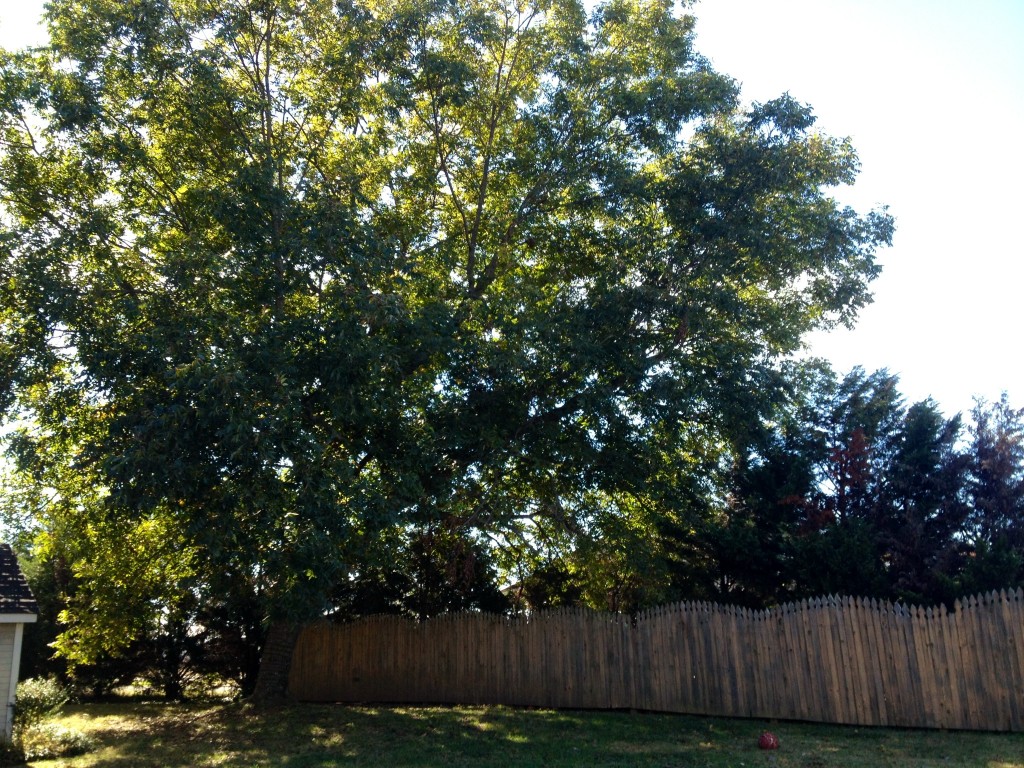
Pecan tree planted by my great-grandparents in Monrovia, Alabama.
For more information please consult Pecan Cultivars for North Florida or contact your local UF IFAS county extension office.
by Les Harrison | Oct 25, 2013
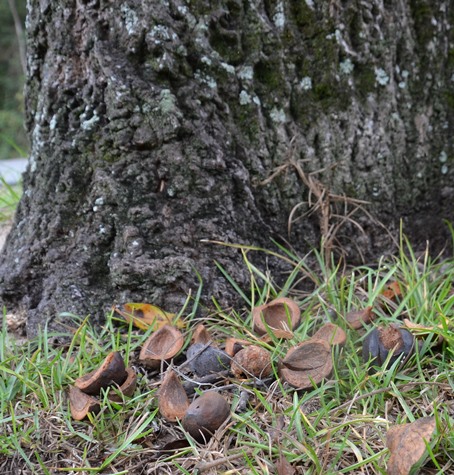
Hickory nuts are popular with squirrels in the autumn.
There is a lot to be gained from having a tough reputation. Only those with a stout disposition or lack of good sense will dare to make a challenge to the individual who hold this distinction.
Unbending, rigid and durable are descriptors which invoke a firm, if not dogmatic, state of resiliency. With this enviable identity, many compare themselves and some assimilate the traits they most admire.
Andrew Jackson is a good case in point. The seventh president grew up on the frontier, dueled with enemies, and commanded an army during the War of 1812 where he was given the nickname Old Hickory.
Like Jackson, hickories are native to North America and are highly valued for their long wearing qualities. While this president no longer visits north Florida, there are plenty of hickories growing in home landscapes.
There are three hickories in panhandle Florida, bitternut, mockernut and water. The water hickory is usually found in wetter areas and the other two species in upland sites.
This genus, Carya, is found in North America and East Asia. The term identifying this genus was coined in Greek mythology and originally referred to a woman who was transformed to a walnut tree.
Karya, or so the story goes, was the daughter of a divinely well-connected king who had gained favor with Apollo. As a courtesy, Karya and her sisters were granted the skill of prophecy from the deity.
As is typical of Greek myths and soap operas, the sisters misused their gift of divination and were punished. Karya was turned into a walnut tree by her boyfriend who was the mythological god of winemaking and ritual madness.
Legendary tragedies aside, hickory trees have a wide variety of contemporary uses commercially and environmentally.
The wood of hickories is relatively hard and is used where a durable and sturdy material are required. Tool handles and flooring are two of the most common uses today.
Prior to the development of modern composite materials, hickory lumber was utilized in vehicle parts, golf club shafts, archery equipment, and a variety of other uses which anticipated hard use. Hickory was originally used to construct baseball bats until ash gained popularity because of its lighter weight.
Hickories are an excellent specimen tree in a landscape. These tall, deciduous trees usually grow from a single trunk and provide excellent shade during the summer.
The leaves can deliver a bright yellow show in the autumn and, if planted on the south side of a home, provide passive solar heating during the cooler months. Mockernut and water hickory nuts have been used in recipes, but are difficult to crack.
One caution is not to establish a hickory near a home or other structure. Squirrels will quickly identify the nuts as a food source and can be quite messy.
Another problem issue is if a tree falls during a storm. The logs are quite heavy and will likely crush anything they hit, especially homes and vehicles.
Hickory is popular and long burning firewood. It is also widely used by bar-b-q devotees who prize the distinct flavor it imparts.
To learn more about hickory trees in north Florida , visit the nearest UF/IFAS County Extension Office or read this infromative publication on the water hickory.
by Julie McConnell | Oct 14, 2013
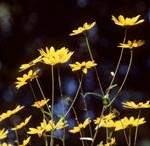
Swamp Sunflower Photo credit: UF/IFAS Milt Putnam
Fall Blooming Native Wildflowers
Drive along any highway or rural road at this time of year and chances are some color will catch your eye; not so much in the tree tops, but in ditches and right of ways.
Although yellow seems to be the predominant color in the fall, pay attention and you may spot reds, oranges, and even some blues in the wildflower pallet.
Examples of wildflowers that bloom late summer to early fall in the Panhandle:
• Bluestar (Amsonia ciliate), blue flowers, 1-3’
• Butterfly Weed (Asclepias tuberosa), orange flowers, 1-3’
• Lanceleaf Coreopsis (Coreopsis lanceolata), yellow flowers, 1-2’
• Leavenworth’s Coreopsis (Coreopsis leavenworthii), yellow flowers, 1-3’
• Swamp Sunflower (Helianthus angustifolia), yellow flowers, 2-6’
• Rayless Sunflower (Helianthus radula), purple flower, 2-3’
• Cardinal Flower (Lobelia cardinalis), red flowers 2-4’
• Lyreleaf Sage (Salvia lyrata), purple flowers, 1-2’
• Goldenrods (Solidago spp.), yellow flowers, 1.5-6’
• Tall Ironweed (Veronia angustifolia), purple flowers, 2-4’
To learn more about these and many other wildflowers read EDIS Publication “Common Native Wildflowers of North Florida.”
by Carrie Stevenson | Sep 2, 2013
One of the natural phenomena I’ve loved watching this rainy summer is the dramatic “life and death” cycle of the resurrection fern (Pleopeltis polypodioides). Found most often along the branches and trunks of stately mature live oaks, this plant turns from a dry, crackly brown to a vibrant green in the span of a day.
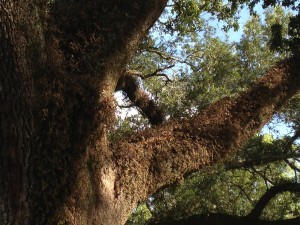
Dry, brown resurrection fern on a live oak after a period without rain. Photo credit: Carrie Stevenson
Like Spanish moss this epiphyte, or “air plant”, uses a host plant (live oak, pecan, or sabal palm) as its growing surface. Yet the fern does not damage the tree. Its root system is composed of long, winding rhizomes that tuck into the nooks and crannies of the tree’s bark, collecting rainwater and nutrients from airborne dust and nutrients leaching from the trees themselves.
The fern’s unusual response to dry weather is an adaptation that allows the fronds to curl inward, reducing water loss by decreasing surface area exposed to the elements.
Blades of turf-grass will respond similarly to drought, folding in half after several days with no water. However, the resurrection fern takes drought tolerance to a whole new level, capable of losing up to 97% of its water content without dying. As a comparison, most plants will start to die back at a 10% water loss. Several researchers estimate the fern can live 100 years in its dry state. However, true to its name, the resurrection fern will spring back to life after a rain or an increase in humidity.
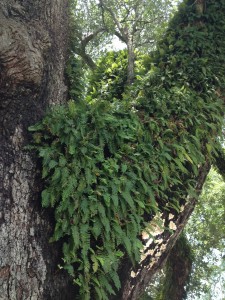
The fern that was completely dry one day will turn a vibrant green just after a rainfall. Photo credit: Carrie Stevenson
The resurrection fern has earned its place in history for several other reasons. According to literature from early pioneers and indigenous people, members of the Florida Seminole and Miccosukee tribes used the fern in baths to treat insanity. They also made a root mixture of the resurrection fern and Shoestring fern (Vittaria lineata) to treat chronic health conditions and sick babies.
Because of its unique attributes, resurrection ferns were taken in space along with the shuttle Discovery in 1997 as part of a mission to better understand natural phenomena from the perspective of space.

The thin, elongated rhizomes of the resurrection fern root into the crevices of a live oak’s bark. Photo credit: Carrie Stevenson
The plant is native to the eastern United States west to Texas and throughout the American tropics. A variety of the species is also native to southern Africa. It can be propagated by cutting several inches of the rhizomes and placing them into crevices of another tree, log, or rocky area. Dry fronds will respond to being sprayed with water in under an hour, so it’s also a fun experiment to show kids!
For more on resurrection ferns, check out the UF School of Forest Resources.












